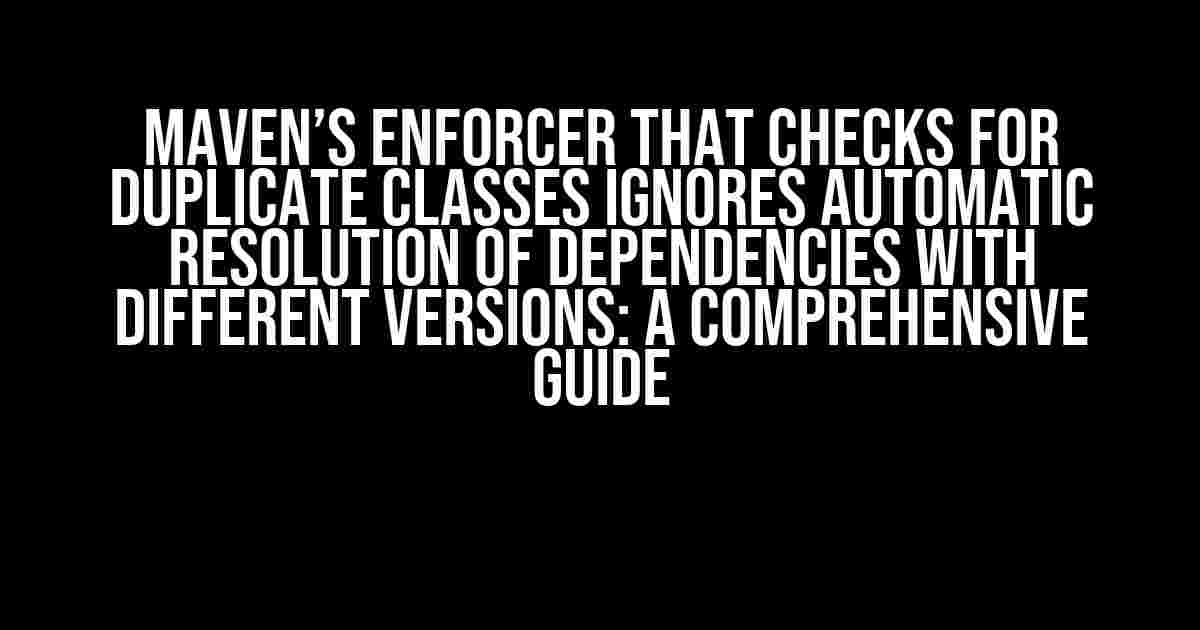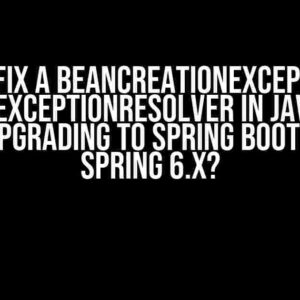When working with Maven, developers often encounter issues related to duplicate classes, which can lead to errors and conflicts in the project. Maven’s enforcer plugin provides a solution to this problem by checking for duplicate classes and ensuring that only one version of a class is used. However, what happens when you have dependencies with different versions? In this article, we will explore Maven’s enforcer plugin and how it handles duplicate classes, including automatic resolution of dependencies with different versions.
What is Maven’s Enforcer Plugin?
The Maven Enforcer Plugin is a tool that allows developers to define and enforce rules for their projects. It provides a way to ensure that certain conditions are met, such as the presence of specific dependencies or the absence of duplicate classes. The enforcer plugin is highly customizable, allowing developers to create their own rules and plugins to suit their needs.
How Does the Enforcer Plugin Check for Duplicate Classes?
The enforcer plugin checks for duplicate classes by scanning the project’s classpath and identifying classes that have the same fully qualified name (FQN). If it finds any duplicate classes, it will fail the build and provide an error message indicating the duplicate classes. This ensures that only one version of a class is used in the project, preventing conflicts and errors.
Automatic Resolution of Dependencies with Different Versions
In Maven, dependencies with different versions can cause issues when resolving duplicate classes. By default, Maven will use the version of the dependency that is declared in the project’s pom.xml file. However, what happens when you have multiple dependencies with different versions? In this case, Maven’s dependency resolution mechanism comes into play.
How Does Maven Resolve Dependencies with Different Versions?
Maven resolves dependencies with different versions using a process called “dependency resolution”. During this process, Maven analyzes the dependencies declared in the project’s pom.xml file and determines the best version of each dependency to use. This is done by evaluating the following factors:
- Dependency versions declared in the pom.xml file
- Dependency versions declared in the parent pom.xml file (if applicable)
- Dependency versions declared in the dependencyManagement section of the pom.xml file
- Dependency versions declared in the pluginManagement section of the pom.xml file
Maven will use the highest version of a dependency that is declared in the pom.xml file or its parent. If a dependency is declared with a version range (e.g., [1.0,2.0)), Maven will use the highest version within that range.
How Does the Enforcer Plugin Handle Duplicate Classes with Different Versions?
Now that we understand how Maven resolves dependencies with different versions, let’s explore how the enforcer plugin handles duplicate classes in this scenario.
Default Behavior
By default, the enforcer plugin will ignore automatic resolution of dependencies with different versions when checking for duplicate classes. This means that if you have multiple dependencies with different versions, the enforcer plugin will not consider the automatic resolution of these dependencies when checking for duplicate classes.
For example, consider the following scenario:
<dependencies>
<dependency>
<groupId>com.example</groupId>
<artifactId>library</artifactId>
<version>1.0</version>
</dependency>
<dependency>
<groupId>com.example</groupId>
<artifactId>library</artifactId>
<version>2.0</version>
</dependency>
</dependencies>
In this scenario, the enforcer plugin will check for duplicate classes by considering both versions of the library dependency (1.0 and 2.0). However, it will not take into account the automatic resolution of the dependency versions by Maven. This means that if the enforcer plugin finds a duplicate class in both versions of the library, it will fail the build, even if Maven would have automatically resolved the dependency to the higher version (2.0).
Customizing the Enforcer Plugin’s Behavior
While the default behavior of the enforcer plugin may not be ideal in all scenarios, it can be customized to handle duplicate classes with different versions differently. The enforcer plugin provides a range of configuration options that can be used to customize its behavior.
For example, you can use the ignoreVersions option to ignore specific versions of a dependency when checking for duplicate classes:
<build>
<plugins>
<plugin>
<groupId>org.apache.maven.plugins</groupId>
<artifactId>maven-enforcer-plugin</artifactId>
<version>3.2.1</version>
<executions>
<execution>
<goals>
<goal>enforce</goal>
</goals>
<configuration>
<rules>
<rule>
<implementation>org.apache.maven.plugins.enforcer.BannedDependencies</implementation>
<ignoreVersions>1.0</ignoreVersions>
</rule>
</rules>
</configuration>
</execution>
</plugin>
</plugins>
</build>
In this example, the enforcer plugin will ignore version 1.0 of the library dependency when checking for duplicate classes. This means that if a duplicate class is found in both versions of the library, the enforcer plugin will only consider the higher version (2.0) when checking for duplicate classes.
Best Practices for Handling Duplicate Classes with Different Versions
When working with Maven and the enforcer plugin, it’s essential to follow best practices to ensure that duplicate classes are handled correctly. Here are some tips to keep in mind:
- Use consistent versioning: Ensure that all dependencies use consistent versioning to avoid conflicts and errors.
- Use dependency management: Use Maven’s dependency management features to declare and manage dependencies consistently throughout the project.
- Use the enforcer plugin: Use the enforcer plugin to check for duplicate classes and ensure that only one version of a class is used.
- Customize the enforcer plugin’s behavior: Customize the enforcer plugin’s behavior to handle duplicate classes with different versions correctly.
- Test thoroughly: Test your project thoroughly to ensure that duplicate classes are handled correctly and that the enforcer plugin is configured correctly.
Conclusion
In conclusion, Maven’s enforcer plugin provides a powerful tool for checking for duplicate classes and ensuring that only one version of a class is used. However, when working with dependencies with different versions, the enforcer plugin’s default behavior may not be ideal. By customizing the enforcer plugin’s behavior and following best practices, you can ensure that duplicate classes are handled correctly and that your project builds successfully.
| Best Practice | Description |
|---|---|
| Use consistent versioning | Ensure that all dependencies use consistent versioning to avoid conflicts and errors. |
| Use dependency management | Use Maven’s dependency management features to declare and manage dependencies consistently throughout the project. |
| Use the enforcer plugin | Use the enforcer plugin to check for duplicate classes and ensure that only one version of a class is used. |
| Customize the enforcer plugin’s behavior | Customize the enforcer plugin’s behavior to handle duplicate classes with different versions correctly. |
| Test thoroughly | Test your project thoroughly to ensure that duplicate classes are handled correctly and that the enforcer plugin is configured correctly. |
By following these best practices, you can ensure that your Maven project builds successfully and that duplicate classes are handled correctly, even with dependencies with different versions.
Frequently Asked Question
Maven’s enforcer plugin is a powerful tool for ensuring consistency and quality in your project’s builds. But did you know that it has some limitations when it comes to duplicate classes and automatic dependency resolution?
What does Maven’s enforcer plugin do?
Maven’s enforcer plugin is a tool that checks for certain rules and constraints in your Maven project, such as banning certain dependencies, enforcing specific versions, or checking for duplicate classes. It’s like a quality gatekeeper for your builds!
Why does the enforcer plugin ignore automatic resolution of dependencies with different versions?
The enforcer plugin ignores automatic resolution of dependencies with different versions because it only checks for duplicate classes within a single dependency graph. If a dependency is resolved automatically to a different version, the plugin won’t catch the duplicate class. It’s like the plugin is looking at the dependency tree through a narrow lens!
How can I work around this limitation?
One way to work around this limitation is to use the dependency:tree goal to generate a dependency tree, and then analyze it manually or using a script. You can also try using other plugins, such as the dependency-convergence plugin, to detect version conflicts. It’s like getting a wider lens to see the entire dependency landscape!
What are some common scenarios where this limitation might cause issues?
This limitation might cause issues in scenarios where you have complex dependency graphs, or when you’re using dependency management features like dependency mediation or dependency convergence. It can also cause problems when you’re using plugins that automatically resolve dependencies, such as the spring-boot-starter-parent plugin. It’s like navigating a treacherous dependency jungle!
Is there a way to configure the enforcer plugin to detect duplicate classes in all dependencies, including automatically resolved ones?
Unfortunately, there is no straightforward way to configure the enforcer plugin to detect duplicate classes in all dependencies, including automatically resolved ones. However, you can raise a feature request or contribute to the enforcer plugin’s development to add this functionality. It’s like helping to create a more powerful quality gatekeeper!


